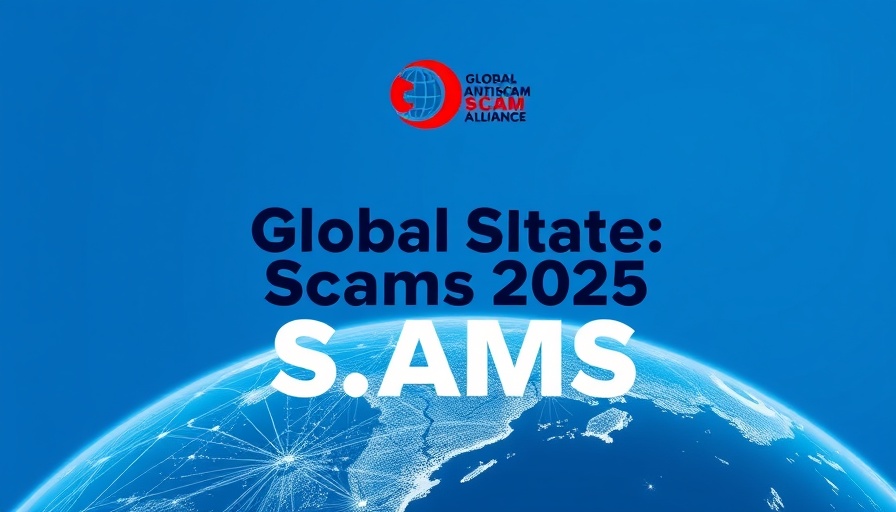
The Global Scams Landscape: Understanding the Threat
In recent years, scams have evolved into a concerning global issue, impacting millions worldwide. The Global Anti-Scam Alliance (GASA) and Feedzai's Global State of Scams 2025 Report reveals shocking insights regarding the prevalence and impact of scams on society. Surveys conducted with 46,000 adults across 42 countries uncover a grim reality: $442 billion was lost to scams in a single year, reflecting widespread vulnerabilities among even the most cautious individuals. It's crucial to examine these findings closely to understand the nuances of victimization and potential pathways for reform.
Shifting Demographics: Who Are Today's Scam Victims?
The traditional image of a scam victim—often an elderly, less educated individual—has drastically changed. According to GASA, 57% of adults reported being scammed in the past year, and approximately 23% of them lost money. Surprisingly, younger generations, particularly Gen Z and millennials, are particularly susceptible, with rates of scam victimization of 27% and 26%, respectively. This notable demographic shift challenges our stereotypes of who is vulnerable to fraudulent schemes.
Moreover, the emotional toll of scams is evident. Victims report heightened stress and a significant loss of confidence. In fact, 69% of those affected experienced anxiety as a result of their encounters. Such psychological effects can linger far longer than the financial implications, making it essential for society to empathize and provide support for victims.
Types of Scams: Most Common Threats of 2025
The report highlights alarming statistics about the types of scams that thrive in today's digital landscape. The most frequently encountered scams include shopping scams (54%), investment scams (48%), and unexpected money scams (48%). These figures suggest a clear pattern of targeting unsuspecting victims through familiar channels, exploiting their trust.
Interestingly, shopping scams are particularly rampant, illustrating how quickly scammers can take advantage of the online retail boom. Awareness of these prevalent scams can empower consumers to practice vigilance when shopping online. For example, understanding how scammers craft fake websites or advertisements can help consumers avoid falling prey to fraud.
Why Are Scams Underreported?
Despite the shocking statistics, the vast majority of scams go unreported. GASA's report indicates that nearly three-quarters of scam victims shared their experiences, yet many still hesitate to report these incidents to authorities due to shame, fear of judgment, or uncertainty about where to seek help. This reluctance is compounded by a culture that often blames victims rather than sympathizes with them.
As detailed in the F-Secure Scam Intelligence & Impacts Report 2025, only 7% of scams are reported globally. This stark conclusion highlights not only a significant gap in the data but also calls for urgent measures to break the cycle of silence surrounding scams. Government and advocacy groups need to foster a more supportive environment where victims feel safe sharing their stories.
The Role of Technology in Scam Prevention
Technology plays a dual role in the war against scams. On one hand, advances in technology can be harnessed to prevent fraud. Institutions like Feedzai are leading the charge in creating AI-driven solutions to detect and prevent financial crime. However, the same technology employed for defense can also serve the interests of scammers, making it crucial to remain vigilant.
Dr. Megan Squire from F-Secure discusses how AI is being utilized by scammers in sophisticated ways—everything from content generation to basic targeting is becoming more streamlined, making it harder for consumers to identify red flags. As technology evolves, so too must our strategies for protection and detection.
Future Insights: The Next Five Years in Scam Prevention
As GASA emphasizes, international collaboration among banks, cybersecurity, and consumer advocacy organizations is essential for combating the growing threat of scams. Moving forward, it is imperative to build comprehensive frameworks that not only educate consumers about potential threats but also implement preventive measures that account for evolving technologies and human behaviors.
Adapting to the new reality of scams requires more than just awareness; it needs actionable reforms and resources directed towards protecting victims. Encouraging reporting through destigmatization, innovative technological solutions, and fostering communication among organizations can create a safer digital environment.
Conclusion: Taking Action Against Scams
The Global State of Scams 2025 Report illustrates the profound changes taking place in the scams landscape. By re-evaluating our understanding of scam victims, the technologies involved, and the emotional aftermath of scams, we can work towards creating a more supportive infrastructure for all. Scams may increasingly target the unsuspecting, but together, with commitment and collaboration, we can turn the tide in favor of consumers everywhere.
 Add Row
Add Row  Add
Add 




Write A Comment